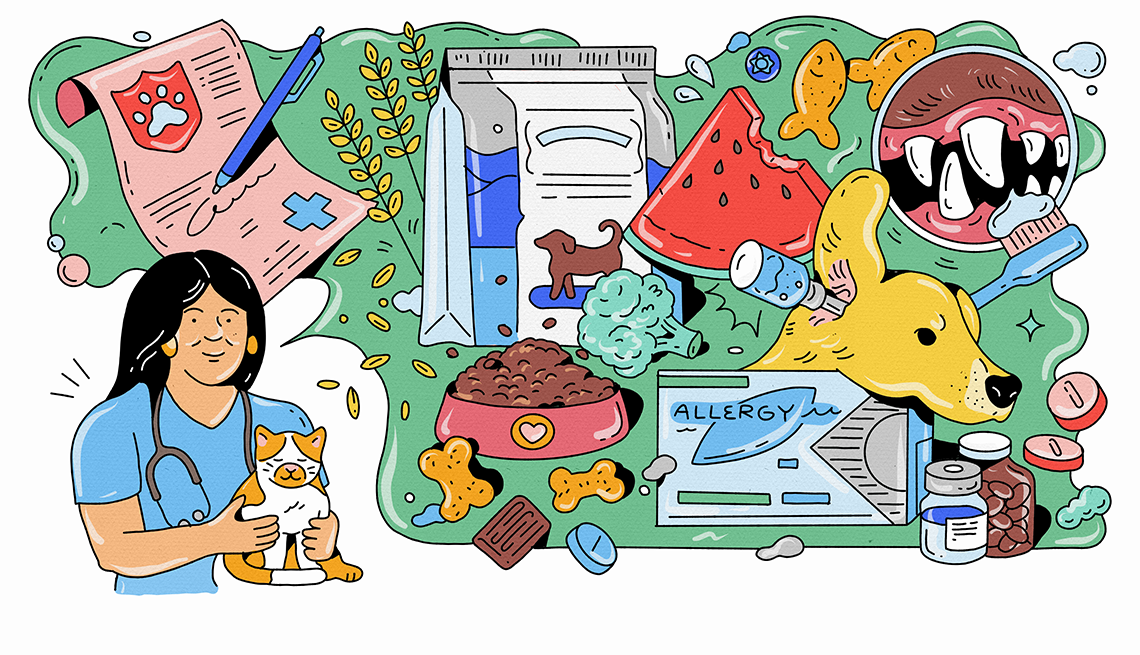
- Select a language for the TTS:
- UK English Female
- UK English Male
- US English Female
- US English Male
- Australian Female
- Australian Male
- Language selected: (auto detect) - EN
Play all audios:
BE ON THE LOOKOUT FOR ALLERGIES Allergies in pets often take the form of itchy skin. Giving your pet an over-the-counter antihistamine like Zyrtec for allergy symptoms may not hurt them, but
it also may not offer much relief. Current research shows that pet allergies aren't necessarily caused by histamines, so an antihistamine is less likely to be effective. Some studies
show that environmental allergies are caused by a defective skin barrier. Then the offending allergens — pollens, dust mites, even human dander — are able to penetrate and trigger an
allergic response. The good news is we have some really effective anti-allergy medications specifically for dogs now. One is an oral pill called Apoquel and another is an injection called
Cytopoint. For dogs that have horrific allergies, these drugs have been a life changer. Unfortunately there are no such drugs for cats, and for them, we often need to resort to
immune-suppressive medications. As for testing, kits that claim they can determine allergies from a hair sample are totally unreliable, and there is no scientific evidence to support
them. For environmental allergies like pollens, dust mites, fungal spores, etc., the most accurate way to test is with intradermal skin testing, usually performed by a veterinary
dermatologist. There are blood tests that can be helpful as well. For food allergies, the only real way to tell what a pet is allergic to is to feed them an elimination diet — a
prescription-limited ingredient or hydrolyzed protein diet is best. TREAT EAR INFECTIONS EARLY Allergies often manifest in skin rashes that can lead to infections — especially in pets’
ears. I don't think a day goes by where I don't see an ear infection. Ears are a warm, moist environment, so it sets this perfect stage for getting a secondary bacterial or yeast
infection. Too often, people let ear infections go on much longer than they should before bringing their pets in. I have dogs coming in with these horrible ear infections that smell
horrific. The dog is scratching and suffering when it didn’t need to. I’d rather see people come in and get ear infections treated right away. To prevent ear infections, clean once a week
with an ear cleanser and cotton ball, but make sure to use one your vet recommends — some products have ineffective ingredients. If ear infections seem to happen often, try to find the
underlying cause, like a food allergy. STAY UP TO DATE ON PREVENTATIVES Studies have shown that dog parks in some regions of the country are just riddled with internal parasites, like
hookworm, which can spread from dog to dog if people aren’t picking up their pet waste. So, if you’re going to be going to the dog park frequently, you want to make sure your dog is up to
date on appropriate preventative medications. There are many products available now that protect against fleas, ticks, heartworm disease and internal parasites all in one medication. BE
CAREFUL IF YOU USE ROGAINE Minoxidil can be very bad if a cat (more so than a dog) were to ingest it. It was originally developed as an oral drug to treat hypertension, so you can imagine if
a cat were to lick some — it could get dangerously low blood pressure. I would encourage people using it to deter their pet from sleeping on their pillow, and make sure the product is
completely dry after applying (probably wait a few hours until the cat has close contact with the owner's head). Also, perhaps the owner should wear gloves when applying. Fortunately,
we have never seen a case in our practice, and I imagine it is very uncommon. PRIORITIZE ORAL HEALTH At-home dental care is really important. Often by the time dogs and cats come in for
dental procedures at our practice, there’s so much oral disease that we end up having to do a lot of extractions, which gets very expensive. With diligent home care, I think a lot of that
could be prevented. Brushing your pet’s teeth daily would be fantastic, but at a minimum, aim for three times a week. Brushing with an actual toothbrush and a toothpaste specially formulated
for pets is best. But, short of brushing, there are also oral rinses, water additives and dental chews that can help remove plaque and tartar. Check the website of the Veterinary Oral
Health Council at VOHC.org for a list of products that have earned its seal of approval for effectiveness.







